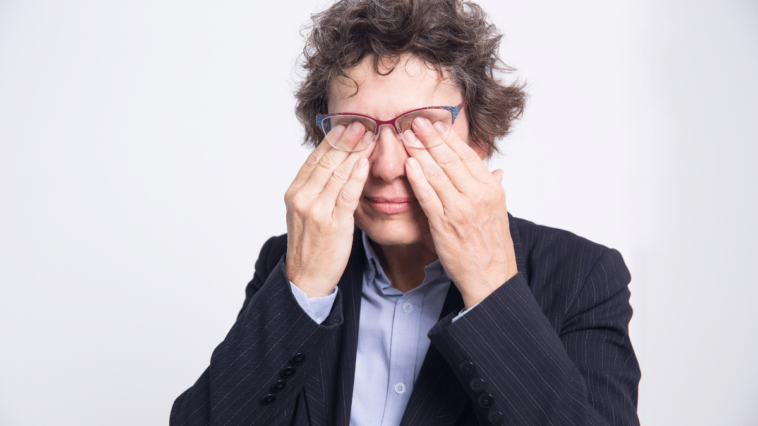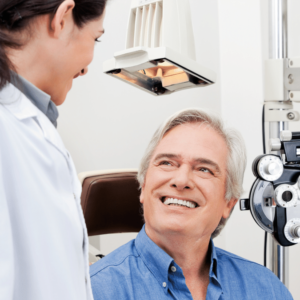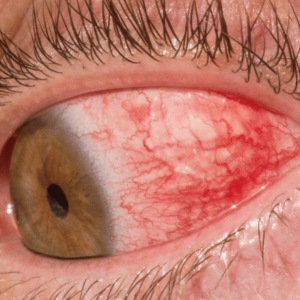Are you experiencing an uncomfortable headache behind your eyes? You’re not alone, as these headaches are quite common. Various conditions, such as eye strain, sinus infections, and migraines, may cause headaches that affect one or both eyes.
If the symptoms of your headache occur frequently, it may indicate that you have a more severe issue, and you should seek medical help. Over-the-counter pain relievers may lessen the discomfort temporarily but will not necessarily get to the root cause of your recurring headaches.
What Causes a Headache Behind the Eyes?

First, identify your headache pain: is it throbbing, stabbing, dull, or something else? Headaches located behind the eyes can have a range of causes, leading to pain and discomfort.
To determine what’s causing your particular type of headache and find effective strategies for managing it, you may need to experiment and try different treatments.
Eye strain
Eye strain, sometimes called digital eye strain or computer vision syndrome, is a set of symptoms experienced by those who use digital devices for long periods.
Signs that one may be suffering from eye strain include:
- Dry eyes
- Headaches, neck and shoulder pain
- Blurred vision.
It is vital to take regular breaks when using digital devices such as laptops or cell phones to avoid these complications.
Experiencing discomfort behind the eyes after using digital screens can signify eye strain. If this continues and any other symptoms arise, it is essential to seek medical attention as computer-related issues multiply.
Migraines
Migraines are a type of severe headache that can cause intense pain, usually behind the eyes or in the temples. While research is still ongoing to determine specific causes, many people find that certain triggers, such as stress, hormone changes, poor posture and diet, medications, and environmental stimuli, can lead to a migraine attack.
Migraine is a complex neurological condition that causes severe, recurrent headaches. Other common symptoms associated with migraine include
- Dizziness
- Weakness
- The tension in the head area
- Nausea and vomiting
- Sensitivity to light and sound
- Mood changes and visual disturbances are known as aura.
Sinusitis
Sinusitis is when the sinuses become inflamed or congested, causing pressure and pain behind one or both eyes. This pain is typically worse when you bend over or lay down, which can be very uncomfortable for sufferers.
Sinusitis can be caused by allergies or a virus, leading to congestion and pressure around the face and head. Occasionally, bacterial or fungal infections may lead to sinusitis, especially in individuals with weakened immune systems, such as HIV.
Symptoms of sinusitis can include pain behind the eyes, headache, stuffiness, and facial pressure. These symptoms can affect both eyes or just one, and their intensity varies depending on the location of the inflammation.
Tension headaches
Tension headaches are a common headache that usually affects more women than men. These headaches tend to produce pressure and tightness around the head.
Tension headaches are classified as either episodic or chronic.
Episodic tension headaches occur from one to two times a month, whereas chronic tension headaches last for more than three months.
These types of headaches can range in intensity and may be accompanied by other symptoms such as neck stiffness and fatigue.
Tension headaches are characterized by pressure around the forehead and pain behind or in both eyes. These headaches may last anywhere from 30 minutes to several days, sometimes lasting several hours.
If you suffer from severe tension headache symptoms, you must see your doctor as soon as possible.
Tension headaches can be caused by various factors, such as not getting enough sleep, stress, prolonged viewing of digital screens, extended periods of driving, and tightness in the muscles around the neck or head.
Cluster headaches
Cluster headaches are severe headaches that cause intense and recurring pain.
These headaches can last between 15 minutes and 3 hours at a time and occur in groups or clusters that can last for weeks or months.
Cluster headaches are a specific type of painful headache that affects one side of the head. The pain is typically described as a sharp or dull throbbing behind one eye and can be severely disabling.
Common symptoms of cluster headaches include a head-splitting headache, usually localized to one side of the head, as well as a stuffy or runny nose, flushing, and sweating on the same side. They are often characterized by occurring at night in clusters— meaning several attacks of varying intensities may occur quickly.
Headaches behind the eyes can have many potential causes, including :
- Lack of sleep
- Stress
- Illnesses/infections.
- Alcohol use
- Smoking
- Hormonal imbalances
- Illnesses/infections.
Identifying and addressing the underlying cause is essential for relieving this headache.
What Are the Risk Factors of a Headache Behind the Eyes?
When experiencing a headache with pain in or behind your eyes could be a sign of an underlying condition such as thyroid problems or glaucoma.
Lifestyle factors can also contribute to this type of headache pain, so changing your life may reduce the risk and severity of these headaches.
If you have sinusitis and allergies, you may find that headaches behind your eyes are more common. Additionally, working at a computer for hours each day can cause headaches due to strain on the eyes.
If you are experiencing a headache located behind your eyes, it is essential to seek treatment right away. It may indicate an underlying condition like scleritis, and avoiding treatment can lead to worsening symptoms or chronic headaches.
How Do You Prevent Headaches Behind the Eyes?
Frequent headaches behind the eyes can be debilitating, but they are not necessarily signs of something serious.
To reduce the frequency of these headaches, it is essential to identify and try to avoid known triggers such as stress, lack of sleep, poor posture, or certain foods. Additionally, seeking treatment can help reduce symptoms and the frequency of headaches if you have a chronic disease or autoimmune disorder.
Other lifestyle changes, such as improving your posture or adjusting your diet, exercising, quitting smoking, and avoiding alcohol, may also help minimize the pain associated with these headaches.
How Do You Diagnose Headache Behind the Eyes?
You must consult your eye doctor if you are experiencing headache pain in the back of your eyes.
As no specific test can be used to determine which type of headache you have, your eye doctor will perform a physical examination, ask about the severity of the symptom and pinpoint possible causes. They may even run tests to check if any underlying medical conditions are causing the problem.
A variety of issues can cause headaches behind your eyes. To correctly diagnose your condition, your doctor will conduct an examination and ask you questions to identify the type of headache. They may classify it as a migraine, tension headache, cluster headache, or sinus headache based on the pattern of your symptoms.
In addition, they will perform a physical exam to check essential factors like vision, coordination, senses, and reflexes.
How to Treat a Headache Behind the Eyes?
Over-the-counter pain medications may relieve mild or moderate headaches, but you must consult your eye doctor for further treatment if the pain persists. In more severe cases, prescription medication might be needed to address the pain adequately.
Your doctor may suggest preventive measures such as antidepressants, antiseizure medications, or oral birth control pills. Try resting in a quiet and dark room to relieve the headache and placing a cold, damp cloth over your eyes.
Depending on the cause of the sinus headache, treatment options can vary. If the headaches are a result of bacterial sinusitis, an antibiotic regimen may be prescribed by your doctor. However, relief can often be found in decongestant nasal sprays if the discomfort is due to allergies or a virus.
Home remedies
The cause of headaches behind the eyes may vary and depend on an individual’s health. Identifying and treating underlying medical conditions helps avoid or ease these headaches.
Headaches behind your eyes can be a symptom of a migraine. To reduce the risk of migraine, it is recommended to avoid certain triggers such as:
- Intense physical or emotional stress,
- Exposure to bright lights or loud noises,
- Sleep deprivation,
- Certain foods, including aged cheeses and processed meats.
Headaches located behind the eyes are one of the main symptoms of tension headaches. There are a few things you can do to manage the discomfort:
- Reduce muscle strain in the head and neck by taking regular breaks from activities such as talking on the phone or looking at digital screens.
- Try to manage stress levels through activities such as yoga or meditation.
- Make sure to get enough rest each night to give your body a chance to relax and recover properly.
Having a headache behind your eyes may be caused by sinusitis. Fortunately, there are things you can do to ease the discomfort and reduce the likelihood of getting headaches in this area. Some lifestyle changes include limiting caffeine consumption, avoiding alcohol and tobacco products, exercising regularly, and eating wholesome, unprocessed foods.
When to See a Doctor?
If you suffer from frequent headaches behind your eyes, you must consult your doctor to determine the cause and get suitable treatment.
A doctor will likely suggest an eye examination and may prescribe treatments that are unavailable over the counter. Additionally, lifestyle changes, such as reducing stress and getting enough sleep, can help prevent the recurrence of pain.
Summary
Experiencing a headache behind your eyes can be an extremely uncomfortable and even painful experience. It may also come with other associated symptoms, making it all the more distressing.
Identifying what is causing the headache is an essential first step before deciding on a treatment plan.
Changing some lifestyle habits may also help lessen the frequency of headaches. This could include avoiding certain triggers such as alcohol, caffeine, or tobacco. Seeking professional medical advice from a doctor is recommended to determine the source of the problem and obtain the best treatment options available.






